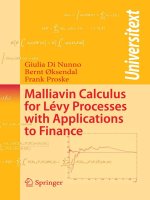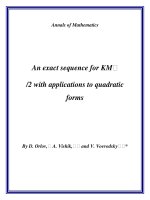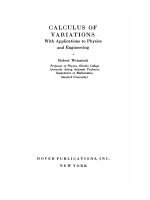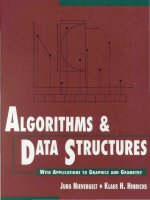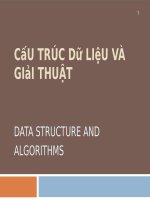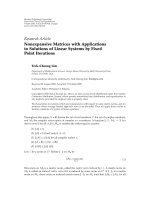detection algorithms for wireless communications with applications to wired and storage systems ferrari, colavolpe raheli 2004 10 08 Cấu trúc dữ liệu và giải thuật
Bạn đang xem bản rút gọn của tài liệu. Xem và tải ngay bản đầy đủ của tài liệu tại đây (19.81 MB, 428 trang )
CuuDuongThanCong.com
DuongThanCong.com
CuuDuongThanCong.com
Detection Algorithms
for
Wireless Communications
CuuDuongThanCong.com
To my parents, Ezio and Ester, for letting me detect my path
Gianluigi Ferrari
To my wife Laura
Giulio Colavolpe
To Annapaola, Enrica and Alberto
Riccardo Raheli
CuuDuongThanCong.com
Detection Algorithms
for
Wireless Communications
With Applications to Wired and Storage Systems
Gianluigi Ferrari, Giulio Colavolpe and Riccardo Raheli
All of
University of Parma
Italy
John Wiley & Sons, Ltd
CuuDuongThanCong.com
Copyright © 2004 John Wiley & Sons Ltd,
The Atrium, Southern Gate, Chichester,
West Sussex PO19 8SQ, England
Telephone
(+44) 1243 779777
Email (for orders and customer service enquiries):
Visit our Home Page on www.wileyeurope.com or www.wiley.com
All Rights Reserved. No part of this publication may be reproduced, stored in a retrieval system or
transmitted in any form or by any means, electronic, mechanical, photocopying, recording, scanning or
otherwise, except under the terms of the Copyright, Designs and Patents Act 1988 or under the terms
of a licence issued by the Copyright Licensing Agency Ltd, 90 Tottenham Court Road, London WIT
4LP, UK, without the permission in writing of the Publisher. Requests to the Publisher should be
addressed to the Permissions Department, John Wiley & Sons Ltd, The Atrium, Southern Gate,
Chichester, West Sussex PO19 8SQ, England, or emailed to , or faxed to
(+44)1243770571.
This publication is designed to provide accurate and authoritative information in regard to the subject
matter covered. It is sold on the understanding that the Publisher is not engaged in rendering
professional services. If professional advice or other expert assistance is required, the services of a
competent professional should be sought.
Other Wiley Editorial Offices
John Wiley & Sons Inc., 111 River Street, Hoboken, NJ 07030, USA
Jossey-Bass, 989 Market Street, San Francisco, CA 94103-1741, USA
Wiley-VCH Verlag GmbH, Boschstr. 12, D-69469 Weinheim, Germany
John Wiley & Sons Australia Ltd, 33 Park Road, Milton, Queensland 4064, Australia
John Wiley & Sons (Asia) Pte Ltd, 2 Clementi Loop #02-01, Jin Xing Distripark, Singapore 129809
John Wiley & Sons Canada Ltd, 22 Worcester Road, Etobicoke, Ontario, Canada M9W 1L1
British Library Cataloguing in Publication Data
A catalogue record for this book is available from the British Library
ISBN 0-471-85828-1
Typeset by the author using LaTex software.
Printed and bound in Great Britain by Antony Rowe Ltd, Chippenham, Wiltshire.
This book is printed on acid-free paper responsibly manufactured from sustainable forestry
in which at least two trees are planted for each one used for paper production.
CuuDuongThanCong.com
Contents
Preface
xi
Acknowledgements
xiii
List of Figures
xv
List of Tables
xxix
1 Wireless Communication Systems
1.1 Introduction
1.2 Overview of Wireless Communication Systems
1.3 Wireless Channel Models
1.3.1 Additive White Gaussian Noise Channel
1.3.2 Frequency Nonselective Fading Channel
1.3.3 Frequency Selective Fading Channel
1.3.4 Phase-Uncertain Channel: Channel with Phase and
Frequency Instabilities
1.4 Demodulation, Detection, and Parameter Estimation
1.5 Information Theoretic Limits
1.5.1 Additive White Gaussian Noise Channel
1.5.2 Frequency Nonselective Fading Channel
1.5.3 Phase-Uncertain Channel
1.6 Coding and Modulation
1.6.1 Block and Convolutional Coding
1.6.2 Linear Modulation without Memory
1.6.3 Combined Coding and Modulation
1.7 Approaching Shannon Limits: Turbo Codes and Low Density Parity
Check Codes
v
CuuDuongThanCong.com
1
1
4
5
6
6
8
9
10
12
12
12
14
15
15
16
17
19
vi
Contents
1.8 Space Time Coding
1.9 Summary
1.10 Problems
2 A General Approach to Statistical Detection for Channels with Memory
2.1 Introduction
2.2 Statistical Detection Theory
2.3 Transmission Systems with Memory
2.3.1 Causality and Finite Memory
2.3.2 Stochastic Channels: Channels with Infinite Memory . . . .
2.4 Overview of Detection Algorithms for Stochastic Channels
2.5 Summary
2.6 Problems
20
21
21
25
25
26
32
35
38
40
43
43
3 Sequence Detection: Algorithms and Applications
49
3.1 Introduction
49
3.2 MAP Sequence Detection Principle
50
3.3 Viterbi Algorithm
51
3.4 Soft-Output Viterbi Algorithm
54
3.5 Finite Memory Sequence Detection
54
3.5.1 Inter-Symbol Interference Channel
57
3.5.2 Flat Slow Fading Channel
58
3.6 Estimation-Detection Decomposition
59
3.7 Data-Aided Parameter Estimation
63
3.8 Joint Detection and Estimation
66
3.8.1 Phase-Uncertain Channel
67
3.8.2 Dispersive Slow Fading Channel
69
3.9 Per-Survivor Processing
71
3.9.1 Phase-Uncertain Channel
75
3.9.2 Dispersive Slow Fading Channel
75
3.9.3 Remarks
75
3.10 Complexity Reduction Techniques for VA-Based Detection Algorithms 76
3.10.1 State Reduction by Memory Truncation
77
3.10.2 State Reduction by Set Partitioning
80
3.10.3 A Case Study: TCM on an ISI Channel
83
3.10.4 Reduced-Search Algorithms
87
3.11 Applications to Wireless Communications
88
3.11.1 Adaptive Sequence Detection: Preliminaries and Least
Mean Squares Estimation
89
CuuDuongThanCong.com
Contents
3.11.2 Noncoherent Sequence Detection for Phase-Uncertain
Channels
3.11.3 Noncoherent Sequence Detection for Slowly Varying
Frequency Nonselective Fading Channels
3.11.4 Linear Predictive Sequence Detection for Phase-Uncertain
Channels
3.11.5 Linear Predictive Sequence Detection for Frequency Flat
Fading Channels
3.11.6 Linear Predictive Sequence Detection for Frequency
Selective Fading Channels
3.12 Summary
3.13 Problems
4 Symbol Detection: Algorithms and Applications
4.1 Introduction
4.2 MAP Symbol Detection Principle
4.3 Forward Backward Algorithm
4.4 Iterative Decoding and Detection
4.5 Extrinsic Information in Iterative Decoding: a Unified View . . . .
4.5.1 A Review of the Use of the Extrinsic Information
4.5.2 Forward Backward Algorithm
4.5.3 Soft-Output Viterbi Algorithm
4.6 Finite Memory Symbol Detection
4.7 An Alternative Approach to Finite Memory Symbol Detection . . .
4.8 State Reduction Techniques for Forward Backward Algorithms . . .
4.8.1 Forward-Only RS-FB Algorithms
4.8.2 Examples of Application of Fwd-Only RS-FB Algorithms .
4.8.3 Forward-Only RS FB-type Algorithms
4.8.4 Examples of Application of Fwd-Only RS FB-type
Algorithms
4.8.5 Generalized RS-FB Algorithms
4.8.6 Examples of Application of Generalized RS-FB Algorithms
4.9 Applications to Wireless Communications
4.9.1 Noncoherent Iterative Detection of Binary Linear Coded
Modulation
4.9.2 Noncoherent Iterative Detection of Spectrally Efficient
Linear Coded Modulation
CuuDuongThanCong.com
vii
95
Ill
124
134
141
146
148
155
155
156
157
162
168
169
172
178
185
191
200
201
204
213
216
222
237
246
246
260
viii
Contents
4.9.3
Pilot Symbol-Assisted Iterative Detection for PhaseUncertain Channels
4.9.4 Linear Predictive Iterative Detection for Phase-Uncertain
Channels
4.9.5 Noncoherent Iterative Detection for Slow Frequency
Nonselective Fading Channels
4.9.6 Linear Predictive Iterative Detection for Fading Channels . .
4.10 Summary
4.11 Problems
272
285
292
294
296
297
5 Graph-Based Detection: Algorithms and Applications
5.1 Introduction
5.2 Factor Graphs and the Sum-Product Algorithm
5.3 Finite Memory Graph-Based Detection
5.4 Complexity Reduction for Graph-Based Detection Algorithms . . .
5.5 Strictly Finite Memory: Inter-Symbol Interference Channels . . . .
5.5.1 Factor Graph
5.5.2 Modified Graph
5.6 Applications to Wireless Communications
5.6.1 Noncoherent Graph-Based Detection
5.6.2 Linear Predictive Graph-Based Detection for PhaseUncertain Channels
5.6.3 Linear Predictive Graph-Based Detection for Frequency Flat
Fading Channels
5.7 Strong Phase Noise: An Alternative Approach to Graph-Based
Detection
5.7.1 System Model and Exact Sum-Product Algorithm
5.7.2 Proposed Algorithms
5.7.3 Numerical Results
5.8 Summary
5.9 Problems
301
301
303
307
312
313
314
318
322
323
A Discretization by Sampling
A.I Introduction
A.2 Continuous-Time Signal Model
A.2.1 Power Spectrum of a Rayleigh Faded Signal
A.2.2 Signal Oversampling
A.2.3 Signal Symbol-Rate Sampling
A.3 Discrete-Time Signal Model
353
353
353
355
359
363
364
CuuDuongThanCong.com
323
326
329
329
333
343
347
349
Contents
ix
References
367
List of Acronyms
387
Index
391
CuuDuongThanCong.com
CuuDuongThanCong.com
Preface
This book presents, in a unitary and novel perspective, some of the research work
the authors have carried out over the last decade, along with several collaborators and
students. The roots of this book can be traced back to the design of adaptive sequence
detection algorithms for channels with parametric uncertainty. The explosion of turbo
codes and iterative decoding around the middle of the Nineties has motivated the
design of iterative (turbo and graph-based) detection algorithms.
This book aims at providing the reader with a unified perspective on the design of
detection algorithms for wireless communications. What does this statement really
mean? It has become clear to us, in recent years, that most of the proposed detection
algorithms evolve from a simple idea, which can be described as finite-memory detection and synthesized by a simple metric. This unique metric is the key ingredient
to derive:
• sequence detection algorithms based on the Viterbi algorithm;
• symbol detection algorithms based on the forward-backward algorithm;
• graph-based detection algorithms based on the sum-product algorithm.
Although simple, and probably familiar to several researchers working in this
area, to the best of our knowledge a unified approach to the design of detection algorithms, based on a single metric, has never been proposed clearly in the literature.
This book tries to address this lack, by giving a comprehensive treatment, with several examples of application.
This book should, however, be interpreted by the reader as a starting point, rather
than a purely tutorial work. In fact, we believe that the proposed simple unifying
idea can find many applications beyond those explored in this book. We would like
to mention a single (and significant) example. In current and future wireless communication systems, it will be more and more important to support high data-rate
transmissions. Multiple-input multiple-output systems, based on the use of multiple
antennas, have received significant interest from the research community over the
xi
CuuDuongThanCong.com
xii
Preface
last years. All the detection algorithms presented in this book apply to single-input
single-output systems. The reader is therefore invited to entertain herself/himself by
trying to extend these algorithms to multiple-input multiple-output communication
scenarios.
A final comment is related to the subtitle: "With Applications to Wired and Storage Systems." As the reader will see, most of the examples presented in this book are
related to wireless communication systems. However, several of the proposed communication scenarios apply also to storage and wired systems: for example, proper
inter-symbol interference channels may characterize several storage systems. Moreover, the proposed approach is general and, therefore, suitable for application to scenarios different from those considered explicitly. Again, the reader is invited to use
the tools proposed in this book and apply them to solve her/his own communication
problems.
As an extra resource we have set up a companion website for our book containing
a solutions manual and a sample chapter. Also, for those wishing to use this material
for lecturing purposes, electronic versions of most of the figures from our book are
available. Please go to the following URL and take a look:
/pub/books/ferrari.
CuuDuongThanCong.com
Acknowledgements
This book would have never been possible without the help of several people across
the years of research, pain and happiness at the University of Parma (and not only).
Since it is impossible to thank explicitly all of them, we would like to take this opportunity to "unitarily" thank all of them, guaranteeing that their help has never been
forgotten, but it is well remembered. In particular, we first wish to thank many students at the University of Parma, who have indirectly contributed to this book with
their thesis works.
Although explicit and comprehensive acknowledgments are impossible, several
researchers must be explicitly mentioned, for particularly significant and important
contributions. We would like to thank Prof. Achilleas Anastasopoulos (University of
Michigan, Ann Arbor, USA), whose collaboration led to some results presented in
Chapter 4. Moreover, we would also like to thank him for kindly proof-reading the
entire manuscript. Many thanks go to Prof. Keith M. Chugg (University of Southern
California, Los Angeles, USA) and Dr. Phunsak Thiennviboon (TrellisWare Technologies Inc., San Diego, USA), for the collaboration (while Gianluigi Ferrari was
visiting the University of Southern California in 2000-2001) from which some results
presented in Chapter 4 come from. The invaluable collaboration of Prof. Giuseppe
Caire (Institut Eurecom, Sophia Antipolis, France) in part of Chapter 5 is acknowledged. This collaboration started while Giulio Colavolpe was visiting the Institut
Eurecom in 2000 and has continued and consolidated in the following years. Thanks
to Dr. Alberto Ginesi and Dr. Riccardo De Gaudenzi (ESA-ESTEC, Noordwijk, The
Netherlands) for their appreciation and encouragement on some results in Chapter 5.
Alan Barbieri (PhD student, University of Parma, Italy) and Gianpietro Germi, are
also acknowledged for their contribution to part of Chapter 5. Going backward in
time, we would like to acknowledge the contribution of Prof. Andreas Polydoros
(University of Athens, Greece) for a long research collaboration which lead to persurvivor processing, described in Chapter 3. We would also like to acknowledge
the contribution of Prof. Piero Castoldi (Scuola Superiore Sant'Anna, Pisa, Italy) to
some of the results described in Chapter 3 and the Appendix. Finally, we wish to acxiii
CuuDuongThanCong.com
xiv
Acknowledgements
knowledge the encouragement and support through the years of our senior colleagues
Prof. Giorgio Picchi (University of Parma, Italy) and Prof. Giancarlo Prati (Scuola
Superiore Sant'Anna, Pisa, Italy), who first appreciated our scientific achievements.
Besides research collaborators, several people have helped in the process of editing the manuscript. Among them, we would like to thank Alessandra De Conti, who
read very carefully the entire manuscript, providing extremely valuable comments
on the English style. Luca Consolini (PhD student, University of Parma, Italy) is
also thanked for reading the entire manuscript and providing comments. We wish
also to thank Annuccia Babayan, for proof-reading parts of the manuscript, and
Michele Franceschini (PhD student, University of Parma, Italy), for providing useful
comments and helping significantly in the editing process. Prof. Enrico Forestieri
(Scuola Superiore Sant'Anna, Pisa, Italy) is finally acknowledged for using his vast
knowledge of ETgX to solve a few (unsolvable to us) editing problems and make the
manuscript more compliant with the requests of the Publisher.
Last, but not least, we heartly wish to thank several people at John Wiley and
Sons Ltd, who made the realization of this book possible. First of all, we are greatly
indebted to our Development Editor, Sarah Hinton, who first believed in this project
and promoted it. Our gratitude goes also to our Publishing Editor, Mark Hammond,
who supported the project along its entire realization. Finally, the Project Editor, Dan
Gill, is thanked for managing very efficiently the editorial phase of the manuscript
and the Copyeditor, Helen Heyes, is also thanked for providing extremely detailed
corrections to the final version of the manuscript.
CuuDuongThanCong.com
List of Figures
1.1 Examples of wireless channel models
1.2 Classical model of a communication system
1.3 Lower bound on the noncoherent channel capacity for different values of N. Reproduced from [44] with permission of John Wiley &
Sons
1.4 Rate-1/2 convolutional encoder with generators G\ = 5 and G^ = 7.
2.1
2.2
2.3
2.4
2.5
2.6
7
11
15
22
M-ary signaling and detection
Discretization of the received signal
Decision regions
Transmission system
Constellation for 32-APSK
Possible communication systems. Reproduced from [92] by permission of John Wiley & Sons
26
29
30
33
44
Add-compare-select operation in a VA
Receiver based on estimation-detection decomposition
Training and tracking operational mode
PSP-based detection. .
Trellis evolution: universal and PSP-based estimation
Pictorial description of trellis folding
Set partitioning for 8-PSK constellation
TCM encoder and mapping for 16-QAM (the subsets are specified in
Figure 3.9)
3.9 Set partition and mapping rule for 16-QAM constellation
3.10 Equivalent discrete-time channel response of an ISI channel
3.11 Performance of TCM with 16-QAM for transmission over the 4tap ISI channel considered in Figure 3.10. Reproduced from [106],
©1996 IEEE, by permission of the IEEE
53
61
67
73
74
78
81
3.1
3.2
3.3
3.4
3.5
3.6
3.7
3.8
xv
CuuDuongThanCong.com
45
84
84
85
86
xvi
List of Figures
3.12 SER performance of uncoded QPSK transmission over a 3-tap dispersive fading channel and LMS-based adaptive detection. The normalized Doppler rate is foT = 1.85 x 10~3. Reproduced from [34],
©1995 IEEE, by permission of the IEEE
3.13 SER performance of uncoded QPSK transmission over a 3-tap dispersive fading channel and LMS-based adaptive detection with dual
diversity. The normalized Doppler rate is foT = 3.69 x 10~3. . . .
3.14 SER performance of PSP-based detection of a TCM with 8-PSK. For
comparison, the performance of a conventional data-aided receiver
(with d = 2) is also shown. Reproduced from [34], ©1995 IEEE, by
permission of the IEEE
3.15 BER of NSD detection schemes for 16-DQAM with various degrees
of complexity. Reproduced from [47], ©1999 IEEE, by permission
of the IEEE
3.16 BER of NSD detection schemes for 8-state TC-16-QAM. Reproduced from [47], ©1999 IEEE, by permission of the IEEE
3.17 BER of the proposed detection schemes for 16-DQAM on the two
considered ISI channels and various values of N. The noncoherent
detectors search a trellis with £' = 256 states. Reproduced from [47],
©1999 IEEE, by permission of the IEEE
3.18 BER of the proposed receiver for DQPSK with N = 5 and £' = 1
for various values of phase jitter standard deviation (white marks)
and frequency offset (black marks). Reproduced from [47], ©1999
IEEE, by permission of the IEEE
3.19 System model in the case of a channel with phase and frequency
uncertainty
3.20 Examples of indistinguishable sequences: (a) noncoherent receiver
(zero-th order); (b) advanced receiver with frequency estimation (first
order). Reproduced from [117], ©2002 IEEE, by permission of the
IEEE
3.21 BER of the receiver based on (3.137) (white marks) for DQPSK and
comparison with NSD (black marks) and coherent receivers. The
frequency offset is v — 0. Reproduced from [117], ©2002 IEEE, by
permission of the IEEE
3.22 BER of the receiver based on (3.137) (white marks) for DQPSK,
N = 6, L = 11, and f' = 16. The performance of an NSD receiver
(black marks) with N = 6 and (J = 16 is also shown for comparison.
Reproduced from [117], ©2002 IEEE, by permission of the IEEE. .
CuuDuongThanCong.com
92
93
95
100
101
102
103
104
107
109
110
List of Figures
xvii
3.23 BER at an SNR of 10 dB versus the normalized frequency offset of
the receiver based on (3.137) for DQPSK and N = 6, L = 6, and
£' = 16. Method 1 (white marks) based on a limitation of the estimation interval and method 2 (black marks) based on DDE are considered. The performance of an NSD receiver with N = 6 and £' = 16 is
also shown for comparison. Reproduced from [117], ©2002 IEEE,
by permission of the IEEE
Ill
3.24 System model for transmission over a frequency nonselective fading
channel. Reproduced from [120], ©2000 IEEE, by permission of the
IEEE
112
3.25 BER of the proposed receivers with and without CSI, 5 = 4 and
TV = 2, for differentially encoded 16-QAM and Rice fading with
KR = 10 dB. The performance of an ideal coherent receiver is also
shown for comparison. Reproduced from [120], ©2000 IEEE, by
permission of the IEEE
122
3.26 BER of the proposed receivers with and without CSI, ("' = 4 and
N — 2, for differentially encoded 16-QAM and Rayleigh fading.
The performance of an ideal coherent receiver is also shown for comparison. Reproduced from [120], ©2000 IEEE, by permission of the
IEEE
123
3.27 BER of the proposed receiver without CSI, (' = 4 and TV = 3, for differentially encoded QPSK, slow Rayleigh fading and various values
of phase noise standard deviation (black marks). The performance of
a coherent receiver based on a decision-directed PLL (white marks) is
also shown for comparison. Reproduced from [120], ©2000 IEEE,
by permission of the IEEE
124
3.28 Eb/N0 as a function of the phase noise standard deviation for BER
equal to 10~3 of the proposed receiver without CSI, f' = 1 and N —
3, for differentially encoded QPSK, slow Rayleigh fading (black marks),
and comparison with a coherent receiver based on a decision-directed
PLL (white marks). Reproduced from [120], ©2000 IEEE, by permission of the IEEE
125
3.29 System model for linear prediction-based receivers
126
3.30 BER of a TCM scheme with 16-QAM. Linear predictive receivers
with various complexity levels are considered. For comparison, the
performance of the equivalent coherent receiver is also shown. . . .
130
CuuDuongThanCong.com
xviii
List of Figures
3.31 Prediction coefficients as a function of the phase noise standard deviation
a are considered. Reproduced from [128], ©2003 IEEE, by permission of the IEEE
132
3.32 BER as a function of the phase noise standard deviation CTA for DQPSK,
symbol by symbol decision, and various values of the frequency offset intensity a. Reproduced from [128], ©2003 IEEE, by permission
of the IEEE
133
3.33 BER of a linear predictive receiver for transmission of QPSK over a
time-varying flat Rayleigh fading channel. Various values of the normalized maximum Doppler rate are considered. Reproduced from [124],
©1995 IEEE, by permission of the IEEE
141
3.34 BER of the blind recursive detector with (3 = 1 for Eb/N0 = 40
dB and BPSK as a function of the assumed memory N. Reproduced
from [121] by permission of John Wiley & Sons
146
3.35 BER versus Eb/N0 of the blind recursive detector with (3 — 1 for
QPSK modulation and p — 0.998. Reproduced from [121] by permission of John Wiley & Sons
147
3.36 BER versus E^/No of the blind recursive detector with (3 — 1 and
(3 = 2 for BPSK modulation and p = 0.99. Reproduced from [121]
by permission of John Wiley & Sons
148
4.1
Transmission system and MAP symbol detection
156
4.2
Parallel concatenated convolutional code, or turbo code
163
4.3
Turbo decoder for a PCCC
164
4.4
Typical BER performance curves of a turbo code for an increasing
number of iterations. Reprinted from [33], ©IEEE, by permission of
the IEEE
166
4.5
Decoder for a turbo code of rate 1/2
170
4.6
BER of a turbo code and the FB algorithm. The extrinsic information generated by each decoder is either modeled as a Gaussiandistributed random variable (first method) or used to update the a
priori probabilities (second method). The considered numbers of iterations are 1, 3, 6 and 18. Reproduced from [147], ©2001 IEEE,
by permission of the IEEE
177
CuuDuongThanCong.com
List of Figures
4.7
4.8
4.9
4.10
4.11
4.12
4.13
4.14
4.15
4.16
Average value of ratio r]z /a^ versus the number of iterations, for various values of SNR and a turbo code. The component decoders use the
FB algorithm. The extrinsic information generated by each decoder
is modeled as a Gaussian-distributed random variable (first method).
Reproduced from [147], ©2001 IEEE, by permission of the IEEE. .
BER of a serially concatenated code and FB algorithm. The considered numbers of iterations are 1, 3, 6 and 18. Reproduced from [147],
©2001 IEEE, by permission of the IEEE
Average value of ratio TJZ/(T^ versus number of iterations, for various
values of SNR and a serially concatenated code. The component decoders use the FB algorithm. The extrinsic information generated by
each decoder is modeled as a Gaussian-distributed random variable
(first method). Reproduced from [147], ©2001 IEEE, by permission
of the IEEE
BER of the proposed detection schemes for a turbo code and SOVA.
The extrinsic information generated by each decoder is either modeled as a Gaussian-distributed random variable (first method) or used
to update the a priori probabilities (second method) or heuristically
weighted (third method). The considered numbers of iterations are
1, 3 and 18. Reproduced from [147], ©2001 IEEE, by permission of
the IEEE
Average value of the ratio ry^/cr^ versus the number of iterations, for
various values of SNR by considering a turbo code. The component
decoders use SOVA. The extrinsic information generated by each decoder is considered as a Gaussian-distributed random variable (first
method)
BER of a serially concatenated code and SOVA. The considered numbers of iterations are 1, 3, 6 and 18. Reproduced from [147], ©2001
IEEE, by permission of the IEEE
Average value of the ratio r)z/cr% versus the number of iterations, for
various values of SNR and a serially concatenated code. The component decoders use SOVA. The extrinsic information generated by
each decoder is considered as a Gaussian-distributed random variable
(first method)
Communication system
Implicit phase estimation in the forward recursion, backward recursion and completion for the NCSOa algorithm
Implicit phase estimation in the forward recursion, backward recursion and completion for the NCSOb algorithm
CuuDuongThanCong.com
xix
178
179
180
183
184
185
186
186
198
199
xx
List of Figures
4.17 Noncoherent iterative decoding of a PCCC with BPSK. For comparison the performance of the corresponding coherent receiver is also
shown. In all cases 1,5, and 10 decoding iterations are considered. . 200
4.18 Noncoherent iterative decoding of an SCCC with 8-PSK. For comparison the performance of the corresponding coherent receiver is
also shown. In all cases 1 and 5 decoding iterations are considered. . 201
4. 19 Forward recursion for the computation of a& (sk) for a Fwd-only RSFB algorithm in the case of coherent detection for an ISI channel.
Reproduced from [156], ©2001 IEEE, by permission of the IEEE. . 206
4.20 Backward recursion for the computation of (3k(s'k) for a Bwd-only
RS-FB algorithm in the case of coherent detection for an ISI channel.
The survivor map is constructed during this recursion. Reproduced
from [156], ©2001 IEEE, by permission of the IEEE
.........
207
4.21 Application of the proposed technique to iterative decoding/detection
for an ISI channel. Receivers with various levels of complexity are
considered and compared with the full-state receiver (£ = 16). The
considered numbers of iterations are 1 and 6 in all cases. The performance in the case of coded transmission over an AWGN channel, without ISI, is also shown (solid lines with circles). Reproduced
from [156], ©2001 IEEE, by permission of the IEEE
.........
209
4.22 Application of the proposed Fwd-only state reduction technique to
iterative decoding/detection, through linear prediction, for flat fading
channels with /DT = 0.01. Receivers with various levels of complexity (in terms of prediction order TV and reduced-state parameter
Q) are shown. The considered numbers of iterations are 1 and 6
in all cases. The performance in the case of decoding with perfect
knowledge of the fading coefficients is also shown (solid lines). Reproduced from [156], ©2001 IEEE, by permission of the IEEE. . . 214
4.23 Forward recursion of the pdf &k(tk) for a general Fwd-only RS FBtype algorithm. Reproduced from [156], ©2001 IEEE, by permission of the IEEE
............................
217
4.24 Backward recursion of the pdf /^(e fc ) for a general Fwd-only RS
FB-type algorithm. The metric c/>k is calculated using the survivor
map previously constructed in the forward recursion. Reproduced
from [156], ©2001 IEEE, by permission of the IEEE
.........
217
CuuDuongThanCong.com
List of Figures
4.25 Application of the RS-NCSOb algorithm to noncoherent decoding
of an RSC code. Receivers with various levels of complexity are
considered and compared with a full-state receiver (TV = 2) and the
coherent receiver. Reproduced from [156], ©2001 IEEE, by permission of the IEEE
4.26 Transmitter and receiver for the uncoded BPSK transmission over
ISI/AWGN channels
4.27 Performance comparisons of various self-iterative detection algorithms
for Channel A assuming perfect CSI. The number of considered selfiterations / is 1 (solid lines) or 5 (dashed lines), and the number of
states is indicated by £' in the case of state reduction. For comparison, the performance of the full-state receiver (f = 2048) is also
shown. Reproduced from [166], ©2002 IEEE, by permission of the
IEEE
4.28 Performance comparisons of various self-iterative detection algorithms
for Channel B assuming perfect CSI. The number of considered selfiterations / is 1 (solid lines) or 5 (dashed lines), and the number of
states, in the case of state reduction, is indicated by £'. For comparison, the performance of the full-state receiver (£ = 2048) is also
shown. Reproduced from [166], ©2002 IEEE, by permission of the
IEEE
4.29 Performance comparisons of various self-iterative detection algorithms
for Channel C assuming perfect CSI. The number of considered selfiterations / is 1 (solid lines) or 5 (dashed lines), and the number of
states is indicated, in the case of state reduction, by £'. For comparison, the performance of the full-state receiver (£ = 2048) is also
shown. Reproduced from [166], ©2002 IEEE, by permission of the
IEEE
4.30 Performance of a (2,1,9) NRC code with generators G\ = 7604 and
G2 = 4174 with BPSK on an AWGN channel. / = 1 (solid lines)
and 7 = 5 (dashed lines) self-iterations are considered for different
numbers of reduced states £' and different packet length K. The
performance in the full-state case (£ = 512 states) is also shown. . .
4.31 Performance of a (2,1,12) NRC code with generators d = 42554
and G2 = 77304 with BPSK on an AWGN channel. / = 1 (solid
lines) and 7 = 5 (dashed lines) self-iterations are considered for different numbers of reduced states £'. A packet length K = 128 is
considered in all cases, and for comparison, the performance of a
full-state (C = 128) (2,1,7) convolutional code is also shown
CuuDuongThanCong.com
xxi
222
239
240
241
242
243
244
xxii
List of Figures
4.32 Transmitter and receiver for the TCM system over an ISI/AWGN
channel
245
4.33 Performance comparison of various iterative detection algorithms for
the TCM/ISI channel (Opt. 1: (/i,/ 0 ) = (1,1), (Mo) = (1,1);
Opt. 2: (/ i} / 0 ) = (3,5), (Mo) = (1,1); Opt. 3: (/i,/ 0 ) = (2,6),
(Mo) = (0.625,0.375); Opt. 4: (/ i? / 0 ) = (2,10), (Mo) =
(0.625,0.375)). Reproduced from [166], ©2002 IEEE, by permission of the IEEE
246
4.34 Communication system model for transmission over phase-uncertain
channels
247
4.35 Schemes with separate detection and decoding using the proposed
soft-output noncoherent algorithms: (a) transmitter and (b) receiver. 250
4.36 Receiver with combined detection and decoding for a PCCC of rate 1/2.
Reproduced from [162], ©2000 IEEE, by permission of the IEEE. . 251
4.37 BER of the proposed iterative detection schemes using the NCSOb
algorithm with predetection (dot-dashed curves), combined detection
and decoding (solid curves), coherent decoding (dashed curves), and
coherent predetection (dotted curves). The numbers of iterations are
1, 3, 6, and 18 in all cases. Reproduced from [162], ©2000 IEEE,
by permission of the IEEE
252
4.38 BER of the proposed receivers using SO-NSD with combined detection and decoding for asymmetric (dotted curves) and symmetric
(dashed curves) schemes. The numbers of iterations are 1, 3, 6 and 18
in both cases. The performance for coherent decoding (solid curve)
and 18 iterations is also shown. Reproduced from [162], ©2000
IEEE, by permission of the IEEE
254
4.39 Application of the Fwd-only RS NCSOb algorithm to noncoherent
decoding of a PCCC. Receivers with various levels of complexity
are considered and compared with a full-state receiver (with N — 3)
and a coherent receiver. The considered numbers of iterations are
1, 3 and 6 in all cases. Reproduced from [156], ©2000 IEEE, by
permission of the IEEE
255
4.40 BER of the proposed detection scheme using SO-NSD with combined detection and decoding for various levels of phase noise. In all
cases, the number of iterations is 6. Reproduced from [162], ©2000
IEEE, by permission of the IEEE
256
4.41 Iterative decoding of serially concatenated interleaved codes. Reproduced from [162], ©2000 IEEE, by permission of the IEEE
257
CuuDuongThanCong.com

